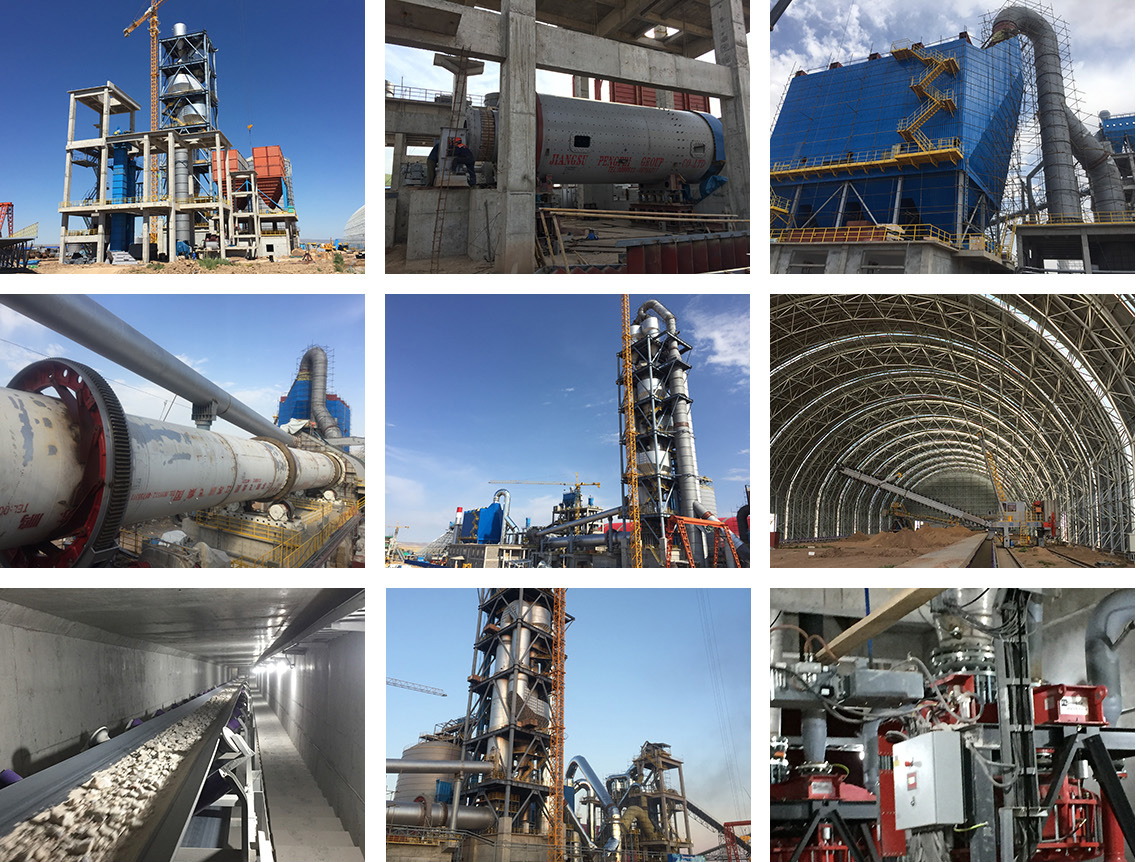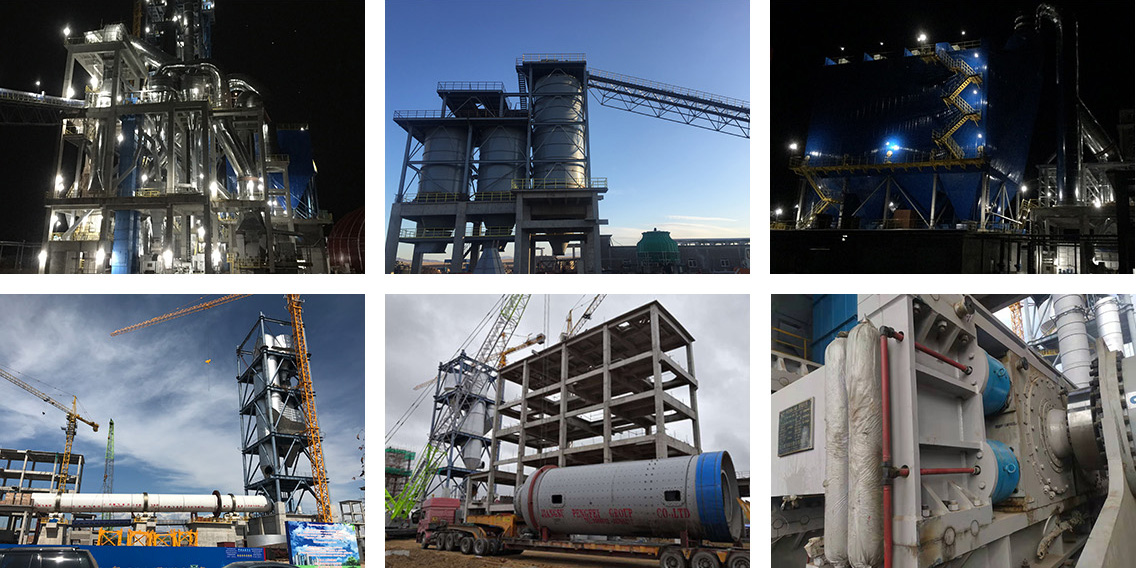Cement production line with annual output of 1.2 million tons
Pengfei EPC cement production line project includes process design, equipment supply (including mechanical and electrical parts), civil engineering, installation and commissioning, trial operation, reaching the production standard and final delivery and other services. Mechanical equipment includes limestone crushing and conveying, clay crushing, raw coal crushing, raw coal and auxiliary raw material pre homogenization yard, raw material proportioning station, raw material grinding and waste gas treatment, raw material homogenization silo and raw material feeding into kiln, firing kiln tail, firing kiln middle and tertiary air pipe, firing kiln head.
Introduction
Pengfei EPC cement production line project includes process design, equipment supply (including mechanical and electrical parts), civil engineering, installation and commissioning, trial operation, reaching the production standard and final delivery and other services. Mechanical equipment includes limestone crushing and conveying, clay crushing, raw coal crushing, raw coal and auxiliary raw material pre homogenization yard, raw material proportioning station, raw material grinding and waste gas treatment, raw material homogenization silo and raw material feeding into kiln, firing kiln tail, firing kiln middle and tertiary air pipe, firing kiln head, clinker conveying, clinker storage and conveying, pulverized coal preparation and metering conveying, cement proportioning station and clinker Bulk, gypsum, mixture crushing and conveying, cement grinding and conveying, cement storage and conveying, cement packaging, bagged cement loading, cement truck bulk, machine repair workshop and total material warehouse.Process parameter
(1)Clinker output:≥3300 t/d ;(2)Clinker burning heat consumption
(3)Comprehensive power consumption of clinker
(4)Comprehensive power consumption of cement
(5)20days strength of clinker
(6)dust exhausting content
Manufacturing method
In cement production, limestone and clay are used as the main raw materials, which are crushed, proportioned and milled into raw materials by roller press, then fed into the cement rotary kiln to calcine the mature materials, and then the clinker is added with a proper amount of gypsum, mixed with some mixed materials or additives, then rolled and milled into cement by roller press and cement mill, and then transported out of the factory by packaging machine or bulk machine. Cement production equipment usually adopts the dry cement production process. The method of drying raw materials at the same time and grinding them into raw meal powder and feeding them into a dry rotary kiln to calcine them into clinker. The main advantage of dry production is low heat consumption.Process description
The limestone is poured into the hopper by the limestone crushing dump truck. After being crushed by the hammer crusher, it is sent to the limestone pre homogenization yard by the belt conveyor. The cantilever stacker is used for layered stacking and reclaiming. The limestone taken out is sent to limestone batching bin of raw material batching station by belt conveyor. An electromagnetic iron remover is arranged on the warehousing belt conveyor to remove the possible iron parts in limestone. The head of the belt conveyor is equipped with a metal detector to detect whether there are iron parts left in the raw materials, so as to avoid damage to the raw material grinding roller press. The raw material batching station is equipped with limestone, clay and other batching bins. The bottom of each batching bin is equipped with a plate feeder and a quantitative feeder. Four kinds of raw materials are discharged by their respective quantitative feeders according to the proportion required by the batching. The materials are fed into the small bin of the raw material grinding roller press through the belt conveyor.Roller press system is adopted for raw material grinding, and high temperature waste gas discharged from kiln tail is used as drying heat source. After being extruded by roller press, the materials are dried and graded by V-type powder concentrator. After the fine powder is selected by high-efficiency powder concentrator, part of the fine powder is sent to raw meal homogenization silo by air conveying chute and bucket elevator.
The coal mill is set at the end of the kiln. Part of the waste gas from the end of the kiln is used as the drying heat source of the raw coal after being collected by the cyclone. After humidification and cooling of kiln tail gas by humidification tower, it will directly enter into the electric dust collector at kiln tail. The water spray volume of humidification tower will be automatically controlled according to the temperature of waste gas at the outlet of humidification tower, so that the temperature of waste gas is within the allowable range of electric dust collector at kiln tail. The purified waste gas of dust collector will be discharged into the atmosphere by exhaust fan. The kiln ash collected by the humidification tower is sent to the kiln feeding system or raw meal homogenization silo through the conveying equipment. A continuous raw meal homogenization silo is set up. The raw meal in the silo is discharged to the mixing chamber from the surrounding ring area after being inflated alternately and evenly in the mixing chamber. The required bottom inflation is supplied by the configured roots blower. After being measured, the homogenized raw meal is conveyed to the inclined trough and bucket elevator by air, and then fed to the two feed ports of the double series preheater respectively by the distributing valve and the air lock valve.
The firing workshop is composed of five-stage double series suspension preheater, decomposing furnace, rotary kiln, grate cooler and corresponding dedusting system, with a daily output of 3300t clinker. The raw material fed into the preheater is preheated by the preheater and decomposed in the decomposing furnace, and then fed into the kiln for calcination; the high-temperature clinker out of the kiln is cooled in the grate cooler, and the large clinker is crushed by the crusher, and then collected together with the small clinker leaked to the air chamber, and then sent to the clinker warehouse for storage by the clinker chain bucket conveyor. In addition to providing high temperature secondary air and tertiary air to the kiln and decomposition furnace respectively, the hot air through the clinker bed is discharged into the atmosphere by the exhaust fan after being purified by the electric dust collector. After the clinker is unloaded by the unloading device at the bottom of the silo, it is sent to the bulk truck station by the belt conveyor, and the bulk clinker is directly loaded by the dust-free bulk head at the bottom of each silo.
The pulverizing system is adopted for the preparation of pulverized coal, and the high temperature waste gas discharged from the kiln tail is used as the drying heat source. The raw coal is fed into the coal mill by the quantitative feeder under the raw coal bunker for drying and grinding. The pulverized coal out of the mill enters the bag type dust collector along with the air flow. The qualified pulverized coal is collected and sent to the pulverized coal bunker with the load sensor by the screw conveyor. The pulverized coal is metered and sent to the burner at the kiln head and the decomposing furnace at the kiln tail for combustion. The dust containing gas is purified by the anti-static bag dust collector and then discharged into the atmosphere by the exhaust fan. The coal bunker and bag type dust collector are equipped with CO detector device and explosion-proof valve. A central laboratory is set up in the whole plant to be responsible for the inspection of raw fuel, semi-finished products and finished products; and an air compressor station is set up to supply compressed air for the production of the whole plant.
The clinker, gypsum and additives in the cement batching station system are metered by the quantitative feeder at the bottom of the silo, and then fed into the cement grinding system for grinding by the belt conveyor and the elevator. The cement grinding system is composed of two sets of pfg160-140 roller press Φ 3.2 × 13m ball mill.
The cement is stored in a 2 - φ 18m round warehouse. The cement discharged from the warehouse is discharged to the cement metering bin through the unloading port at the bottom of each bin. The cement metering bin is equipped with a load sensor and an inflation device. There are four discharge ports under the bin, and each discharge port is equipped with flow control valve and flowmeter. The metered cement is sent to the cement packaging system through the air conveying chute, and the other two are used for bulk loading at the bottom of the bin. The design capacity of the bulk system is 150t / H.
Technical


| Item No. | No. | Name | Specification | Unit | Quantity |
| 02 | 01 | Apron feeder | Model:B2200×10000mm | set | 1 |
| 12 | 10 | Jaw crusher | Model:TPE100 | set | 1 |
| 41 | 10 | Roller press | Model:PFG180-120 left installed | 台 | 1 |
| Diameter of extruding roller:1800mm | |||||
| Width of extruding roller:1200mm | |||||
| Passing through:600~850t/h | |||||
| Feeding granularity: ≤50mm | |||||
| Output:260t/h | |||||
| 56 | 01 | Rotary kiln | Size:Φ4.3×60m | 台 | 1 |
| Output::3300t/d | |||||
| No. Of support roller device: 3 | |||||
| Water consumption of each support roller:4m3/h | |||||
| Inclination:4% | |||||
| Auxiliary rotating speed:7.93r/h | |||||
| 57 | 01 | Kiln Hood | Size:Φ4.3x60m rotary kiln kiln hood | 台 | 1 |
| 57 | 02 | Coal powder burning device | Coal powder spraying:7.5t/h/max:10t/h | 台 | 1 |
| Central height of coal spraying pipe:1500mm | |||||
| 57 | 08 | Grate cooler | Model:SCLW4-8X12-RC | 台 | 1 |
| Cooling capacity:Design capacity 3300t/d Max. Capacity 3600t/d | |||||
| 57 | 17 | EP filter | Model:29/12.5/4*9/0.45 | 台 | 1 |
| 73 | 04 | Air swept coal mill | Size:Φ3.4×(6.5+2.5)m | 台 | 1 |
| Capacity:30t/h | |||||
| Feeding granularity:≤25mm | |||||
| Fineness of finished product:0.08mm hole screen,residue≤3% | |||||
| 84 | 31~32 | Cement mill | Size:Φ3.2x13m | 台 | 2 |
| Capacity:110t/h | |||||
| Feeding granularity≤2mm | |||||
| Feeding moisture content:≤0.5% | |||||
| Blaine:3200±100cm2/g |

